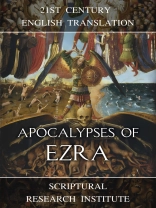In the early centuries of the Christian era, a number of texts called the Apocalypse of Ezra were in circulation among Jews, Christians, Gnostics, and related religious groups. The original is believed to have been written in Judahite or Aramaic, and is commonly known as the Jewish Apocalypse of Ezra, as Ezra is believed to have been an ancient Judahite. This translation is referred to as the Judahite Apocalypse of Ezra, as the book has nothing to do with modern Judaism. This version of the Apocalypse was translated into Greek sometime before 200 AD and circulated widely within the early Christian churches. In the book, it is claimed that the prophet Ezra wrote 904 books, and its popularity seems to have inspired many Christian-era Apocalypses of Ezra, presumably beginning with the ‘Latin’ Apocalypse of Ezra which claimed to be the ‘second book of the prophet Ezra.’ This prophet Ezra is not the scribe Ezra from the books of Ezra, but a prophet named Shealtiel who lived a couple of centuries earlier. In the apocalypse, he is called Ezra by the angel Uriel, which translates a ‘helper’ or ‘assistant.’
The shorter Latin Apocalypse of Ezra has become fused with the Judahite Apocalypse of Ezra in most Catholic and Protestant translations, however, scholars divide the Catholic versions of 4th Esdras into three sections, with only the core twelve chapters that correspond to the Orthodox and Ethiopian versions of the book labeled as 4th Ezra. The opening two chapters, which are only found in the Catholic version, are labeled as 5th Ezra, while the last 2 chapters found in the Catholic version, as well as fragments surviving in an ancient Greek translation, are labeled 6th Ezra. 5th Ezra and 6th Ezra appear to have originally been one document, which is commonly called the Latin Apocalypse of Ezra, although it was almost certainly not written in Latin. There is another Greek Apocalypse of Ezra that has been reconstructed by scholars with a high level of certainty based on ancient fragments and quotes, however, it is a separate text from the Judahite or Latin Apocalypses of Ezra, and appears to be a Christian-era composite of various Ezra related materials.
The Vision of Ezra appears to be either a prequel to the Greek Apocalypse or possibly another reworking of material that served as a basis for both works. In the Vision, Ezra is taken on a tour of the underworld by angels of Tartarus and then is taken to heaven where he begs for mercy for those in the underworld. The text appears to have been written by a Coptic Christian or Gnostic, as the underworld is largely inspired by the ancient Egyptian underworld. There are several unique underworld elements in the Vision that support a Coptic origin, including dogs attacking the dead, two great lions, and an immense worm, all at the western horizon.
Like the Catholic Apocalypse of Ezra, the Syriac Apocalypse of Ezra appears to have been reworked in the High Middle Ages. Another version of the apocalypse has survived in Arabic, but is attributed to Daniel instead of Ezra, an is commonly known as the Arabic Apocalypse of Daniel. The Arabic version is shorter and appears to be older, likely dating to earlier than the time of Muhammad, while the Syriac version has been reworked into an anti-Islamic apocalypse, likely between 1229 and 1244.







![Copertina di Brian Schrag & Julisa Rowe: Community Arts for God's Purposes [Chinese] 貼近神心意的社群藝術 Copertina di Brian Schrag & Julisa Rowe: Community Arts for God's Purposes [Chinese] 貼近神心意的社群藝術](https://static.worldofdigitals.com/thumb_webp/740/9781645083740.webp)




